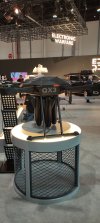,..,.,
China Reveals New Heavily Armed Extra-Large Uncrewed Submarine
New evidence points to China's XLUUV (extra-large uncrewed underwater vehicles) being armed with torpedoes. This is a significant leap in this space and, together with a large-scale development program, may be out-pacing the West.
H I Sutton
23 Feb 2023
Extra large uncrewed underwater vehicles (XLUUVs) are quickly becoming a major trend in naval warfare. Leading navies have initiated programs to develop and explore these. Currently, the U.S. Navy and Royal Navy appear to be in the lead, both in
experimentation and in orders.
But China too has been working on this capability. China has at least 5 designs in the water, many more than any other navy. But their development has been shrouded in secrecy.
CSSC booth at NAVDEX 2023
Now new information from the NAVDEX 2023 defense exposition in Abu Dhabi, UAE reveals details of their designs for the first time. It indicates that some of China’s uncrewed underwater vehicles may be submarine killers.
As Naval News reported in September 2022, China has an
extensive yet unreported XLUUV program. Because China does not discuss these vehicles in public we can only speculate on many details. Defense analysts can look for indications in the crafts’ size, form, where it is tested and from the context of the trials. But the satellite imagery available can only give hints.
The defense expo changes this. The visuals used by Chinese shipbuilding organization CSSC 705 Institute are significant. They show an XLUUV broadly in line with some of the vehicles previously observed in satellite imagery in China.
Displaying a visual of an XLUUV suggests an export product so care needs to be taken extrapolating it to Chinese Navy (PLAN) projects. all the same it is useful information about China’s domestic projects.
Unusually, the XLUUV has a structure along its side which is consistent with flank array sonar. Even more unusually, this is combined with telltale doors for four torpedo tubes in the chin position. Taken together it implies an anti-ship and/or anti-submarine role.
Several other large uncrewed underwater vehicle designs also feature a sonar like this. Notably the French
Oceanic Underwater Drone Demonstrator and South Korean ASWUUV. But the Chinese design is the first to combine it with weapons.
Arming autonomous underwater vehicles with weapons which require target identification, such as torpedoes, is problematic. It increases risks of blue on blue (or for China, red on red) accidents.
It also raises ethical and legal questions about human out of the loop kill chains. This is because underwater vehicles like this cannot realistically be controlled by humans. They have to be autonomous, so the decision to shoot the torpedo has to be automated.
However China appears more comfortable than other nations to take these risks. At least that’s the indication based on what little we know so far.




















